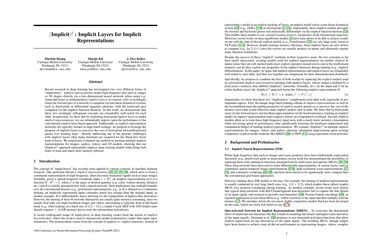$(\textrm{Implicit})^2$: Implicit Layers for Implicit Representations
Recent research in deep learning has investigated two very different forms of ''implicitness'': implicit representations model high-frequency data such as images or 3D shapes directly via a low-dimensional neural network (often using e.g., sinusoidal bases or nonlinearities); implicit layers, in contrast, refer to techniques where the forward pass of a network is computed via non-linear dynamical systems, such as fixed-point or differential equation solutions, with the backward pass computed via the implicit function theorem. In this work, we demonstrate that these two seemingly orthogonal concepts are remarkably well-suited for each other. In particular, we show that by exploiting fixed-point implicit layer to model implicit representations, we can substantially improve upon the performance of the conventional explicit-layer-based approach. Additionally, as implicit representation networks are typically trained in large-batch settings, we propose to leverage the property of implicit layers to amortize the cost of fixed-point forward/backward passes over training steps -- thereby addressing one of the primary challenges with implicit layers (that many iterations are required for the black-box fixed-point solvers). We empirically evaluated our method on learning multiple implicit representations for images, videos and audios, showing that our $(\textrm{Implicit})^2$ approach substantially improve upon existing models while being both faster to train and much more memory efficient.
PDF Abstract NeurIPS 2021 PDF NeurIPS 2021 Abstract